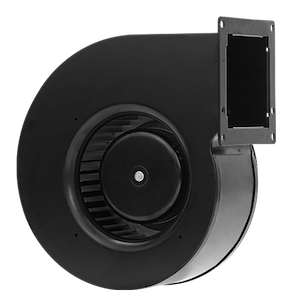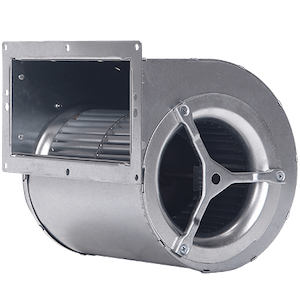FOCUS ON EC FAN ONLY
FOCUS ON EC FAN ONLY
Heating, Ventilation, and Air Conditioning (HVAC) systems rely on blowers to move air effectively through ducts, filters, and conditioned spaces. Blowers are a key component that directly impacts system efficiency, airflow distribution, and energy consumption. Among the most common blower designs are the single inlet blower and the dual inlet blower.
Although both types share the same fundamental purpose—moving air—they differ significantly in structure, performance, and ideal use cases. For engineers, procurement managers, and industrial buyers, understanding these differences is critical to making the right choice for any HVAC application.
This article provides a comprehensive comparison of single inlet vs dual inlet blowers, discussing how they work, their advantages and disadvantages, typical applications, and cost implications.
A single inlet blower (SIB) is designed with a single air intake. Air enters from one side of the impeller and exits through the housing at a perpendicular angle.
Air Intake: One side of the impeller only
Size: Compact, lighter design
Airflow: Limited airflow compared to dual inlet
Efficiency: Best suited for moderate airflow requirements
Compact design makes it easier to install in small spaces
Lower cost due to simpler construction
Reduced power consumption in low-capacity systems
Well-suited for targeted applications where airflow demand is not excessive
Limited airflow compared to dual inlet blowers
May generate uneven airflow in larger duct networks
Not suitable for large-scale HVAC systems requiring high volume air movement

A dual inlet blower (DIB) is designed with two inlets, allowing air to enter from both sides of the impeller simultaneously. The air is then expelled through the housing, delivering higher airflow and more balanced distribution.
Air Intake: Two sides of the impeller
Size: Larger, often heavier than single inlet blowers
Airflow: Much higher airflow capacity
Efficiency: Ideal for high-volume systems requiring balanced distribution
Higher airflow compared to single inlet designs
Provides balanced airflow across large ducts
More energy-efficient in high-volume HVAC systems
Ideal for industrial, commercial, and large building ventilation
Larger and more expensive than single inlet blowers
Requires more installation space
Higher maintenance demands in some configurations

| Feature | Single Inlet Blower (SIB) | Dual Inlet Blower (DIB) |
|---|---|---|
| Air Intake | One side of impeller | Both sides of impeller |
| Airflow Volume | Moderate | High |
| Pressure Capability | Suitable for moderate static pressure | Handles higher static pressure efficiently |
| Size and Installation | Compact and lightweight | Larger, requires more installation space |
| Cost | Lower cost | Higher initial investment |
| Applications | Small HVAC units, appliances, electronics | Commercial HVAC, industrial systems, cold chain |
Single Inlet: Provides directional airflow, suitable for localized ventilation.
Dual Inlet: Delivers more uniform airflow distribution across large duct systems.
Single Inlet: Consumes less power in small systems but less efficient for large-scale applications.
Dual Inlet: More efficient in high-volume HVAC systems, reducing operational costs over time.
Single Inlet: Performs adequately under moderate static pressure but may struggle with heavy filters or complex duct layouts.
Dual Inlet: Handles higher resistance with better stability, making it suitable for filtration-heavy environments.
Single Inlet: Tends to be noisier at higher speeds due to unbalanced airflow.
Dual Inlet: Quieter operation at high volume because airflow is balanced on both sides.
Small residential HVAC systems
Household appliances (air purifiers, vacuum cleaners, heaters)
IT and electronics cooling systems
Compact ventilation units in medical equipment
Large-scale HVAC systems in commercial buildings
Cold storage and cold chain logistics
Industrial ventilation requiring high air volume
Air purification systems with high resistance filters
Data centers requiring continuous, balanced cooling
The cost of blowers depends on factors such as size, airflow capacity, energy efficiency, and housing design.
Single Inlet Blower:
Lower upfront cost
Lower maintenance cost
Best for cost-sensitive applications where airflow demand is limited
Dual Inlet Blower:
Higher upfront investment
Greater long-term energy savings
Delivers better return on investment in industrial or commercial projects
When deciding between single inlet and dual inlet blowers, engineers should consider:
System Size – Smaller systems with moderate airflow needs can benefit from SIBs, while large-scale HVAC projects require DIBs.
Static Pressure Requirements – DIBs are better suited for systems with high resistance or complex ducting.
Noise Control – DIBs generally provide quieter operation in high-volume settings.
Budget – SIBs offer lower upfront costs, but DIBs provide better long-term efficiency.
Application Environment – From compact electronics cooling to industrial cold storage, selecting the right blower ensures optimized performance and cost savings.
PBM is a leading China-based manufacturer of EC (Electronically Commutated) brushless motors and fans, with decades of experience in designing and delivering customized blower solutions.
Comprehensive Product Line: Single inlet blowers, dual inlet blowers, backward curved centrifugal fans, axial fans, duct fans, and more.
High Efficiency: EC technology reduces energy consumption and lowers operational costs.
Reliability: IP55-rated designs available for protection against dust and moisture.
Global Reach: Customers in over 50 countries trust PBM for advanced ventilation solutions.
Custom Solutions: Engineering teams collaborate with clients to design tailored solutions for specific HVAC requirements.
By working with PBM, businesses gain a trusted partner capable of delivering high-quality blowers designed for HVAC, refrigeration, cold chain, IT, medical, and industrial applications.
Both single inlet and dual inlet blowers play a crucial role in HVAC systems, but their suitability depends on application requirements.
Single Inlet Blowers are compact, cost-effective, and ideal for small-scale applications with moderate airflow needs.
Dual Inlet Blowers deliver higher airflow, balanced distribution, and superior performance in large-scale or industrial HVAC systems.
For engineers and procurement managers, the decision comes down to system design, pressure requirements, budget, and long-term energy efficiency.
By partnering with a professional supplier like PBM, businesses can ensure they choose the right blower for their HVAC system, improving reliability and reducing lifecycle costs.
The main advantage is higher airflow and balanced distribution, making dual inlet blowers better for large HVAC systems.
Yes. Single inlet blowers have lower upfront costs and are suitable for small applications, but dual inlet blowers offer better long-term efficiency for large projects.
They can, but due to size and cost, dual inlet blowers are generally more common in commercial and industrial HVAC systems.
Dual inlet blowers tend to operate more quietly at higher airflow because air enters from both sides, balancing the impeller load.
Yes. PBM provides IP55 single inlet and dual inlet blowers that ensure long-lasting performance in environments exposed to dust and moisture.
By continuing to use the site you agree to our privacy policy Terms and Conditions.